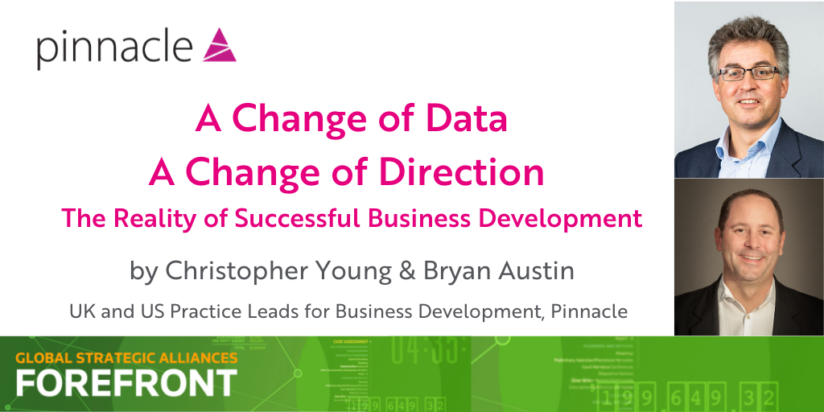
A change of data. A change of direction. The reality of successful business development.
In the latest edition of Forefront Pinnacle’s US and UK Practice Leads for Business Development Christopher Young and Bryan Austin reflect on the takeaways from the Thomson Reuters Marketing Partner Forum in Miami and the reality of successful business development.
With years of experience working in the legal business development sector, it seems strange that many firms still appear to be struggling to build a strong and vibrant key client program. Many firms’ programs are largely ad hoc and driven by the marketing and business development function—if driven by anyone at all.
Growing long-term profitable revenues (the ultimate purpose of these key client programs) requires two things to be brought together and interlinked: a clear direction and leadership.
Clear direction is easily achieved through mining the data that you have. While assessing historic data is easiest, it’s also the least valuable as it only tells you where you’ve come from. It doesn’t tell you where you’re going. Your business’s most profitable future is with organizations that have the greatest and easiest-to-grasp opportunities.
By bringing together historical data and external data, it’s relatively straightforward to identify these rich, easy sources of revenue. Answering questions that help identify the easy sources are ones such as, “Which clients have a similar footprint to our firm?” (You won’t get work from client businesses that you cannot support.) “Which practice areas have been used a bit but not a lot?” (It is easier to get more work from someone that is using you a bit.) “Which clients have the largest spend in the areas where we have a strong capability?” (Firms that are growing in the areas that we are interested in are easier to grow than others.)
Effective Leadership Has to Deploy All of Its Change Levers
Firms without this insight into the easy opportunities will find it challenging to create a successful key client program. Also, it means that any investments in the form of discounts, entertainments, and so on are made sub-optimally. Part of any key client program must be a drive to change this.
Our experience suggests that change in an organization requires effective leadership. But, if we want to move from investing sub-optimally to a higher investment performance, the executive committee must use all of the levers of change: compensation, the meaning of roles, the responsibilities and accountabilities of these roles, and any new skills and resources needed.
Just taking the roles, responsibilities, and accountabilities as an example, exploring “What does it mean to be a client partner as opposed to a matter partner?” can help determine how client partners could or should be measured and how does that differ from matter partners? Getting clarity and feeding this into the assessment, measurement, and ultimately remuneration might be one set of levers to drive better investment decisions within the firm.
We know it works. One global law firm grew its revenues by 20% within two years by focusing not on the largest clients of the last three years but on the easiest clients to grow. Change came from the top: the executive selected the key clients and asked client partners if they wished to work with a team to deliver the identified opportunities. Discounting policies were changed, and the measures and metrics for personal performance were adjusted.
Data Insights Intrinsic to Opportunity Creation
Historically, to achieve the necessary levels of insight into the data, we have had to rely on Excel®, chewing gum, and string. It has been labor-intensive and dependent on key individuals with strong IT technical skills and also commercial/business development know-how. Refreshing the data was almost as hard of work as creating the tool to find the insights in the first place. With 3E Data Insights, it is possible to join the financial data with CRM data with external data and for this to be refreshed in real time. Data Insights has content packs—it ships with either a 3E or Enterprise one. Pinnacle is currently developing content for the Intapp toolsets and also for the common CRM applications.
With the right content packs, you can gather the right internal data and join it with external data feeds very quickly. Some work is needed to structure the data to give you the insights, but once this has been done once, it is quick and easy to refresh. This allows the leadership of the firm and the business development team to focus on driving the change; coaching the key client teams to secure the opportunities.
Using the Data Insights tools allows the leadership to track the progress and to see the activity but also to see it convert into opportunities. In turn, this should feed into better revenue forecasts and turn opportunities into closed business.
Fundamentally, firms should change their data focus from historic data, captured as a function of day-to-day business, to looking at data about the future. It isn’t about the technology: successful business development programs are delivered by changing the data that we look at and leading robust change programs.
